Patellofemoral Pain (Runner’s Knee)
Patellofemoral Pain Syndrome (Runner’s Knee)Rehabilitation Exercises
You can do the hamstring stretch right away. When the pain in your knee has decreased, you can do the quadriceps stretch and start strengthening the thigh muscles using the rest of the exercises.
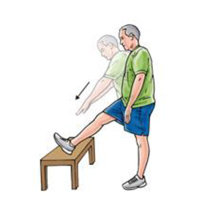
Standing hamstring stretch:
Place the heel of your injured leg on a stool about 15 inches high. Keep your knee straight. Lean forward, bending at the hips until you feel a mild stretch in the back of your thigh. Make sure you do not roll your shoulders and bend at the waist when doing this or you will stretch your lower back instead of your leg. Hold the stretch for 15 to 30 seconds. Repeat 3 times.
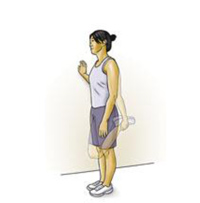
Quadriceps stretch:
Stand an arm’s length away from the wall with your injured leg farthest from the wall. Facing straight ahead, brace yourself by keeping one hand against the wall. With your other hand, grasp the ankle of your injured leg and pull your heel toward your buttocks. Don’t arch or twist your back. Keep your knees together. Hold this stretch for 15 to 30 seconds.

Side-lying leg lift:
Lying on your uninjured side, tighten the front thigh muscles on your top leg and lift that leg 8 to 10 inches away from the other leg. Keep the leg straight and lower slowly. Do 3 sets of 10.
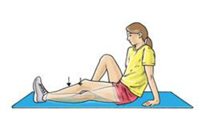
Quad sets:
Sitting on the floor with your injured leg straight and your other leg bent, press the back of the knee of your injured leg against the floor by tightening the muscles on the top of your thigh. Hold this position 10 seconds. Relax. Do 3 sets of 10.
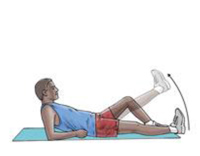
Straight leg raise:
Lie on your back with your legs straight out in front of you. Bend the knee on your uninjured side and place the foot flat on the floor. Tighten the thigh muscle of the other leg and lift it about 8 inches off the floor, keeping the thigh muscle tight throughout. Slowly lower your leg back down to the floor. Do 3 sets of 10.
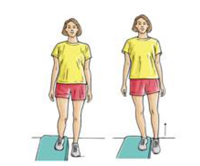
Step-up:
Stand with the foot of your injured leg on a support (like a small step or block of wood) 3 to 5 inches high. Keep your other foot flat on the floor. Shift your weight onto your injured leg on the support straighten your knee as the other leg comes off the floor. Lower your leg back to the floor slowly. Do 3 sets of 10.
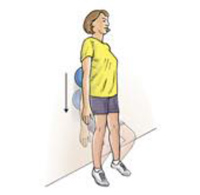
Wall squat with a ball:
Stand with your back, shoulders, and head against a wall and look straight ahead. Keep your shoulders relaxed and your feet 2 feet away from the wall and a shoulder’s width apart. Place a soccer or basketball-sized ball behind your back. Keeping your back upright, slowly squat down to a 45-degree angle. Your thighs will not yet be parallel to the floor. Hold this position for 10 seconds and then slowly slide back up the wall. Repeat 10 times. Build up to 3 sets of 10.
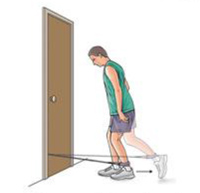
Knee stabilization:
Wrap a piece of elastic tubing around the ankle of the uninjured leg. Tie a knot in the other end of the tubing and close it in a door.
1. Stand facing the door on the leg without tubing and bend your knee slightly, keeping your thigh muscles tight. While maintaining this position, move the leg with the tubing straight back behind you. Do 3 sets of 10.
2. Turn 90 degrees so the leg without tubing is closest to the door. Move the leg with tubing away from your body. Do 3 sets of 10.
3. Turn 90 degrees again so your back is to the door. Move the leg with tubing straight out in front of you. Do 3 sets of 10.
4. Turn your body 90 degrees again so the leg with tubing is closest to the door. Move the leg with tubing across your body. Do 3 sets of 10.
Hold onto a chair if you need help balancing. This exercise can be made even more challenging by standing on a pillow while you move the leg with tubing.
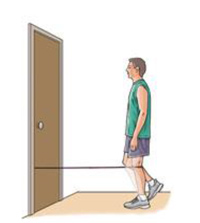
Resisted terminal knee extension:
Make a loop with a piece of elastic tubing by tying a knot in both ends. Close the knot in a door at knee height. Step into the loop with your injured leg so the tubing is around the back of your knee. Lift the other foot off the ground and hold onto a chair for balance, if needed. Bend the knee with tubing about 45 degrees. Slowly straighten your leg, keeping your thigh muscle tight as you do this. Repeat 15 times. Do 2 sets of 15. If you need an easier way to do this, stand on both legs for better support while you do the exercise.
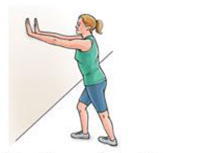
Standing calf stretch:
Facing a wall, put your hands against the wall at about eye level. Keep one leg back with the heel on the floor, and the other leg forward. Turn your back foot slightly inward (as if you were pigeon-toed) as you slowly lean into the wall until you feel a stretch in the back of your calf. Hold for 15 to 30 seconds. Repeat 3 times and then switch the position of your legs and repeat the exercise 3 times. Do this exercise several times each day.

Clam exercise:
Lie on your uninured side with your hips and knees bent and feet together. Slowly raise your top leg toward the ceiling while keeping your heels touching each other. Hold for 2 seconds and lower slowly. Do 3 sets of 10 repetitions.
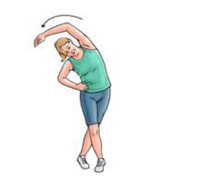
Iliotibial band stretch: Side-bending:
Cross one leg in front of the other leg and lean in the opposite direction from the front leg. Reach the arm on the side of the back leg over your head while you do this. Hold this position for 15 to 30 seconds. Return to the starting position. Repeat 3 times and then switch legs and repeat the exercise.
Written by Tammy White, MS, PT, and Phyllis Clapis, PT, DHSc, OCS, for RelayHealth. Published by RelayHealth.
© 2009 RelayHealth and/or its affiliates. All Rights Reserved.


